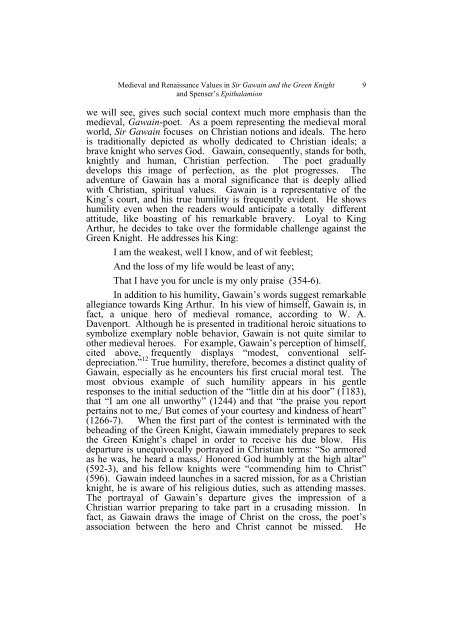Journal of Taibah University the first issue
Journal of Taibah University the first issue
Journal of Taibah University the first issue
Create successful ePaper yourself
Turn your PDF publications into a flip-book with our unique Google optimized e-Paper software.
Medieval and Renaissance Values in Sir Gawain and <strong>the</strong> Green Knight<br />
and Spenser’s Epithalamion<br />
9<br />
we will see, gives such social context much more emphasis than <strong>the</strong><br />
medieval, Gawain-poet. As a poem representing <strong>the</strong> medieval moral<br />
world, Sir Gawain focuses on Christian notions and ideals. The hero<br />
is traditionally depicted as wholly dedicated to Christian ideals; a<br />
brave knight who serves God. Gawain, consequently, stands for both,<br />
knightly and human, Christian perfection. The poet gradually<br />
develops this image <strong>of</strong> perfection, as <strong>the</strong> plot progresses. The<br />
adventure <strong>of</strong> Gawain has a moral significance that is deeply allied<br />
with Christian, spiritual values. Gawain is a representative <strong>of</strong> <strong>the</strong><br />
King’s court, and his true humility is frequently evident. He shows<br />
humility even when <strong>the</strong> readers would anticipate a totally different<br />
attitude, like boasting <strong>of</strong> his remarkable bravery. Loyal to King<br />
Arthur, he decides to take over <strong>the</strong> formidable challenge against <strong>the</strong><br />
Green Knight. He addresses his King:<br />
I am <strong>the</strong> weakest, well I know, and <strong>of</strong> wit feeblest;<br />
And <strong>the</strong> loss <strong>of</strong> my life would be least <strong>of</strong> any;<br />
That I have you for uncle is my only praise (354-6).<br />
In addition to his humility, Gawain’s words suggest remarkable<br />
allegiance towards King Arthur. In his view <strong>of</strong> himself, Gawain is, in<br />
fact, a unique hero <strong>of</strong> medieval romance, according to W. A.<br />
Davenport. Although he is presented in traditional heroic situations to<br />
symbolize exemplary noble behavior, Gawain is not quite similar to<br />
o<strong>the</strong>r medieval heroes. For example, Gawain’s perception <strong>of</strong> himself,<br />
cited above, frequently displays “modest, conventional selfdepreciation.”<br />
12 True humility, <strong>the</strong>refore, becomes a distinct quality <strong>of</strong><br />
Gawain, especially as he encounters his <strong>first</strong> crucial moral test. The<br />
most obvious example <strong>of</strong> such humility appears in his gentle<br />
responses to <strong>the</strong> initial seduction <strong>of</strong> <strong>the</strong> “little din at his door” (1183),<br />
that “I am one all unworthy” (1244) and that “<strong>the</strong> praise you report<br />
pertains not to me,/ But comes <strong>of</strong> your courtesy and kindness <strong>of</strong> heart”<br />
(1266-7). When <strong>the</strong> <strong>first</strong> part <strong>of</strong> <strong>the</strong> contest is terminated with <strong>the</strong><br />
beheading <strong>of</strong> <strong>the</strong> Green Knight, Gawain immediately prepares to seek<br />
<strong>the</strong> Green Knight’s chapel in order to receive his due blow. His<br />
departure is unequivocally portrayed in Christian terms: “So armored<br />
as he was, he heard a mass,/ Honored God humbly at <strong>the</strong> high altar”<br />
(592-3), and his fellow knights were “commending him to Christ”<br />
(596). Gawain indeed launches in a sacred mission, for as a Christian<br />
knight, he is aware <strong>of</strong> his religious duties, such as attending masses.<br />
The portrayal <strong>of</strong> Gawain’s departure gives <strong>the</strong> impression <strong>of</strong> a<br />
Christian warrior preparing to take part in a crusading mission. In<br />
fact, as Gawain draws <strong>the</strong> image <strong>of</strong> Christ on <strong>the</strong> cross, <strong>the</strong> poet’s<br />
association between <strong>the</strong> hero and Christ cannot be missed. He


